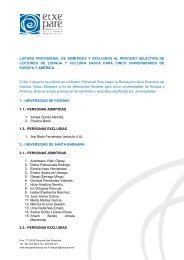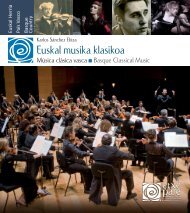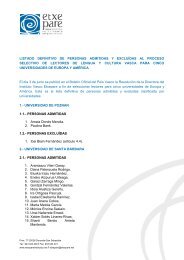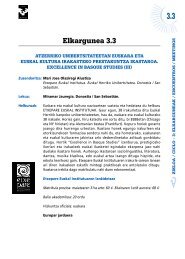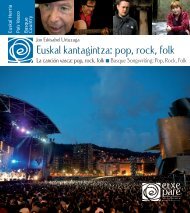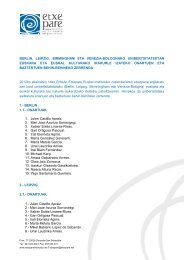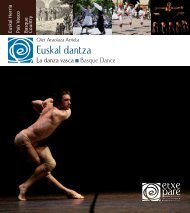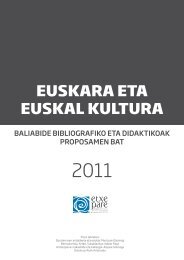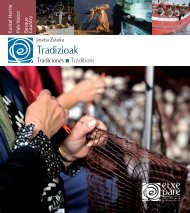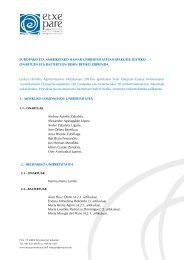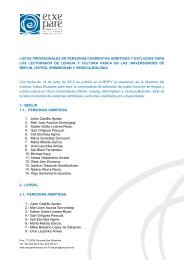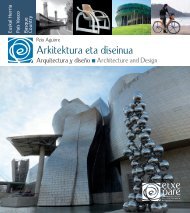XX. mendeko euskal literatura - Etxepare, Euskal Institutua
XX. mendeko euskal literatura - Etxepare, Euskal Institutua
XX. mendeko euskal literatura - Etxepare, Euskal Institutua
Create successful ePaper yourself
Turn your PDF publications into a flip-book with our unique Google optimized e-Paper software.
mostrar la tortura sufrida por los presos políticos<br />
vascos. Una mujer que está presa, Nerea, es la coprotagonista<br />
de Nerea eta biok (1994). En sus últimos<br />
trabajos, Sisifo maite minez (2001) y Ecce Homo<br />
(2006), Mintegi reflexiona sobre el amor y sobre la<br />
aportación que las mujeres pueden hacer a la política,<br />
respectivamente.<br />
En su novela Eta emakumeari sugeak esan zion<br />
(1999) Lourdes Oñederra (1958) rompe con algunas<br />
de las características que se han tendido a considerar<br />
propias de las mujeres (la maternidad, la debilidad,<br />
la pasividad). La serpiente le prometió a Eva que se<br />
haría con toda la sabiduría si comía de la manzana.<br />
Las consecuencias de ese acto, sin embargo, fueron<br />
distintas: la culpa y el castigo, y el tener que vivir sometida<br />
a los hombres. El viaje que la protagonista<br />
de la novela, Teresa de 35 años, hará a W. sirve de<br />
excusa para que ella misma se cuestione y analice el<br />
lenguaje hasta ahora empleado.<br />
En lo que a la narrativa de los últimos años se refiere,<br />
cabe destacar cuatro autores: Harkaitz Cano, Pello<br />
Lizarralde, Unai Elorriaga y Kirmen Uribe.<br />
Harkaitz Cano (1972) ha cultivado tanto la poesía,<br />
como la <strong>literatura</strong> infantil, la crónica, el ensayo y<br />
la narrativa. A este último apartado corresponden<br />
sus libros de narraciones Telefono kaiolatua (1993)<br />
y Neguko zirkua (2005), así como las novelas Beluna<br />
Jazz (1996), Pasaia blues (1998) y la ganadora<br />
del Premio Euskadi de Literatura Belarraren ahoa<br />
(2004). Siguiendo las técnicas del dirty realism o<br />
realismo sucio practicado, entre otros, por Raymond<br />
Carver, la narrativa de Cano se alimenta de<br />
una realidad aparentemente equilibrada para mostrar<br />
sus puntos de ruptura. Así mismo, la principal<br />
característica tanto de su narrativa como de su poesía<br />
es la ciudad posmoderna, una ciudad en la que<br />
no prevalece lo visual tal y como sucede en la ciudad<br />
moderna (Simmel 1900, Benjamin 1936), sino<br />
que es, ante todo, un “state of mind” (Cano 2003:<br />
178). Se trata de una ciudad descentrada, por la que<br />
the Euskadi Prize for Literature. In her more recent<br />
works, the novels Zeruetako erresuma (2005) and<br />
Ezer gabe hobe (2009), she examines the events of<br />
recent decades.<br />
The Basque political situation and the role of women<br />
in it form the basis of the work of Laura Mintegi<br />
(1955). Her first novel, Bai... baina ez (1986), a counterstory<br />
of Jon Mirande’s Haur besoetakoa, is a love<br />
story located outside social norms. Her next work,<br />
Legez kanpo (1991), follows the techniques of detective<br />
fiction to show the torture suffered by Basque<br />
political prisoners. A female prisoner, Nerea, is the<br />
co-protagonist of Nerea eta biok (1994). In her latest<br />
works, Sisifo maite minez (2001) and Ecce Homo<br />
(2006), Mintegi reflects on love and the contribution<br />
that women can make to politics respectively.<br />
In her novel Eta emakumeari sugeak esan zion (1999;<br />
And the Serpent Said to the Woman, 2005) Lourdes<br />
Oñederra (1958) breaks with some features which<br />
have tended to be considered typically female (maternity,<br />
weakness, passivity). The serpent promised<br />
Eve she would get wisdom by eating the apple. The<br />
consequences of this act were, however, varied: guilt<br />
and punishment, and having to live in submission to<br />
men. The journey undertaken by Teresa, the protagonist<br />
of the novel, to W. serves as a pretext for her<br />
to question and analyse the language used to date.<br />
As regards narrative in recent years, four authors<br />
stand out: Harkaitz Cano, Pello Lizarralde, Unai Elorriaga<br />
and Kirmen Uribe.<br />
Harkaitz Cano (1972) has written poetry, children’s<br />
literature, newspaper columns, essays and narrative.<br />
In the latter category are his short story works Telefono<br />
kaiolatua (1993) and Neguko zirkua (2005), as<br />
well as the novels Beluna Jazz (1996), Pasaia blues<br />
(1998) and the winner of the Euskadi Prize for Literature<br />
Belarraren ahoa (2004; Blade of Light, 2010).<br />
Following the techniques of dirty realism practiced<br />
by, amongst others, Raymond Carver, Cano’s narrative<br />
draws on an apparently balanced reality to<br />
41



